Friday, 8 June, 10am-5pm, Birkbeck Cinema, please book here
You can download the abstracts here
The Ha-ha wall, a classic feature of the English park, is said to derive its name from the surprised reaction and amusement of passers-by when confronted with the barrier previously concealed in the landscape. Unseen from one side and obvious from the other, a visual tool for uninterrupted views and a physical barrier at the same time, the Ha-ha wall seems to almost caricature the dichotomies inherent in the wall: both a dividing and a linking element, a condition of both segregation and co-existence, a carefully concealed obstacle and a deterrent visible from far away. It is the wall’s Janus-faced character, which, paradoxically, allows it to occupy a space beyond the division it engenders. This raises questions about the nature of this most traditional building element as well as its contemporary embodiment as a high-tech tool of control. What is it made of? How can a linear element that is a wall be inhabited? What does it mean to occupy the wall itself instead of one or the other side? And finally, how is it possible to breach the wall? Trump’s wall on the Mexican border, the wall on the West Bank as well as barriers, fences and walls in Europe, erected during the refugee crisis in 2015, all point to a dystopian resurgence of the wall in all its political relevance and aesthetic and symbolic complications.
There have been a number of symposia and academic discussions about the recent return of the wall as a spatial manifestation of politics. The organizers of the proposed conference are, however, convinced that focusing merely on the most recent manifestations of spatial divisions without addressing and rethinking intrinsic architectural and aesthetic properties of the wall misses an important opportunity to locate the political not only in the actual historical events but also in the material and spatial make-up of the events themselves. The wall both as a political tool of division and as a material and aesthetic phenomenon frames our ways of perceiving and experiencing historical events. This is why an interdisciplinary discussion, focusing not only the imminent effects of newly-erected spatial divisions, but also questioning the all too self-evident properties of the wall as an architectural element, is vital at this historical moment.
Confirmed speakers at the symposium include Alistair Cartwright (Birkbeck), Mark Crinson (Birkbeck), Michael Diers (Humboldt University Berlin), Kasia Murawska-Muthesius (Birkbeck), James O’Leary (UCL), Wendy Pullan (Cambridge), Leslie Topp (Birkbeck) and Janet Ward (University of Oklahoma).
The conference is organised by Christina Parte (Birkbeck) and Miloš Kosec (Birkbeck).
The event is co-funded by Lorraine Lim Fund and Architecture, Space and Society Centre, Birkbeck.




Leave a Reply